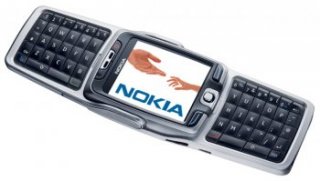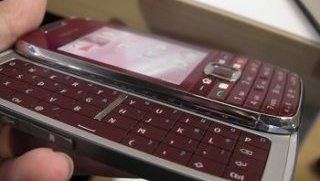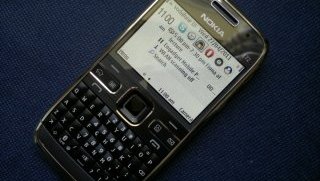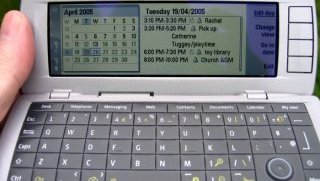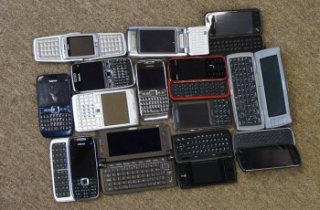 An exercise for the reader, for a rainy day: can you name all the Symbian-powered QWERTY handsets in this photograph? Hint: not all of them are mentioned below, and not all the top 10 are in the photo!...
An exercise for the reader, for a rainy day: can you name all the Symbian-powered QWERTY handsets in this photograph? Hint: not all of them are mentioned below, and not all the top 10 are in the photo!...
However much the fashion seems to be for ever-growing device sizes to accommodate ever-larger touch displays, it seems that, for practical on-the-go access, at least, the likes of the Blackberry Curve remain as popular as ever. Certainly, when mobile, you can't guarantee that both of your hands will be free, you want a certain level of robustness, you want a certain level of insensitivity to unintentional knocks, all situations where pure touchscreen phones have issues.
And don't forget my 2009 attempt to quantitatively rank QWERTY devices, plus David's thoughts on thumb travel and QWERTY speed. All good reading matter.
However, with much of the tech world now going touch-only (a mistake, in my view), with no more Symbian QWERTY on the horizon, with even Blackberry dropping their signature QWERTY keys on the latest Curve, maybe it's time to look back.
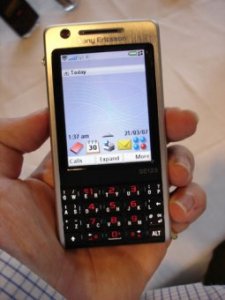 In the interests of a) geek interest and b) nostalgia, I thought a pleasant romp through QWERTY from 2002 to 2012 might be in order. Note that the ranking isn't, obviously, a direct comparison of each device's functions and capabilities today - by that metric, the most recent devices would almost certainly have a huge edge. The ranking here is in my memory, in evaluating how significant each device was for its time, how well constructed and long-lived it was, and (most of all) how well it worked for text entry, for emails, texts, social updates and documents.
In the interests of a) geek interest and b) nostalgia, I thought a pleasant romp through QWERTY from 2002 to 2012 might be in order. Note that the ranking isn't, obviously, a direct comparison of each device's functions and capabilities today - by that metric, the most recent devices would almost certainly have a huge edge. The ranking here is in my memory, in evaluating how significant each device was for its time, how well constructed and long-lived it was, and (most of all) how well it worked for text entry, for emails, texts, social updates and documents.
Not quite making it into the top 10, but worthy of mention are the Sony Ericsson P1i (shown, right) and M600, both with 'dual qwerty' vision, i.e. two letters per key, with the key 'rocking' on a vertical axis as needed. A clever idea that never really worked for me. Plus the similar Nokia E55 with more traditional keys and software working out what you meant to type - this always seemed like a great idea for reducing predictive foulups and miskeys, but again in practice I never managed to get really fast and fluent.
Also 'bubbling under' were the Sony Ericsson P910, a crazy attempt to shoehorn an ultra-miniature qwerty keypad onto the underside of a flip down numeric pad - these insane Swedish designers.; the equally insane (for stylistic reasons) Sony Ericsson P990i, with the numeric keypad folding down to reveal a miniature QWERTY keyboard on the main frame, and the Nokia E61i, which I loved for a good year (at the time) but which just wasn't memorable enough to make the final cut...
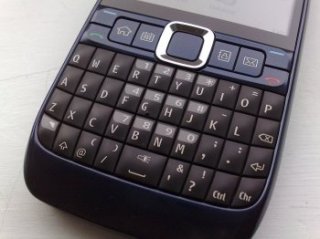 Omitted from the top 10 because it simply wasn't good enough is the Nokia E7 Communicator. Yes, it's still a current device, yes, the screen is superb, yes, the QWERTY keypad is astonishing for its slim size, but the E7 ultimately fails by most real world metrics: the camera is EDoF when a core camera use in Communicators is scanning documents, the internal storage is limited and unexpandable, but worst of all (by a huge margin) is the small, sealed 1200mAh battery. When new, the E7 will just about last a day of moderate use. After six months, the average business man will be running out of juice mid way through the afternoon and with no way to slot in a new battery, temporarily or permanently. QWERTY is so often associated with long battery life and general 'always there for you' reliability, and it's here that the E7 rather falls flat on its face.
Omitted from the top 10 because it simply wasn't good enough is the Nokia E7 Communicator. Yes, it's still a current device, yes, the screen is superb, yes, the QWERTY keypad is astonishing for its slim size, but the E7 ultimately fails by most real world metrics: the camera is EDoF when a core camera use in Communicators is scanning documents, the internal storage is limited and unexpandable, but worst of all (by a huge margin) is the small, sealed 1200mAh battery. When new, the E7 will just about last a day of moderate use. After six months, the average business man will be running out of juice mid way through the afternoon and with no way to slot in a new battery, temporarily or permanently. QWERTY is so often associated with long battery life and general 'always there for you' reliability, and it's here that the E7 rather falls flat on its face.
Also omitted from the 10 was the N97 classic and N97 mini - the former because, despite a feature list that seemed like every fanboy's dream come true, the end result was clunky and plasticky and had some showstopping internal limitations - not least the small system (C) disk which was perennially running out. This latter was fixed in the N97 mini, but then the smaller device was crippled by an underperforming battery and no FM transmitter, rather ruining two of the biggest selling points of the original N97 design. And, I'm afraid, I'm tarring the C6 with the same brush, being essentially an N97 mini with sliding, rather then hinged screen/keyboard. Sorry. Just uninspiring.
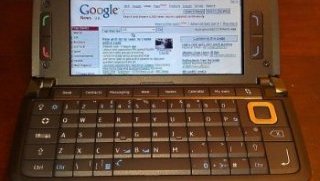 So, in reverse order.
So, in reverse order.
________________________
10. Nokia E63
Essentially the budget version (no GPS, fixed focus 2mp camera, no volume controls, no supplied microSD) of the classic E71, which I'll mention later, the E63 brought Symbian QWERTY to the masses perhaps for the first time. We picked up an E63 on pay-as-you-go for my 9 year old (at the time) daughter, and I believe it generally sold quite well. Constructed all in plastic, the E63 was very durable, had a great keyboard, and even improved on the E71 by having a proper 3.5mm audio jack.
9. Nokia E90
Pilloried at the time by the "You've put WHAT interface on the Communicator?" brigade, the E90 attempted to make the most of the traditional, dual screen clamshell form factor while switching UI tracks from the full-screen, menu-driven, full-QWERTY 'Series 80' to the ever more popular 'S60' (as it was at the time). The result was at times an uneasy fit and many core applications in the S60 ecosystem never did get updated to work properly on the E90's internal screen. Yet I grew to like the E90, spurred on by the excellent metal build quality, the great speakers and (for its time) camera and the giant 4" screen.
8. Nokia E75
When I first handled the E75, I hated it. A numeric keyed phone with side-sliding 'flat' keyboard - and with a tiny 2.4" screen. All very uninspiring. But the E75 was a 'grower', and when I started using it for real, as an experiment, I found it a very capable 'jack of all trades' device, for messaging, Office and camera functions, all in a fairly diminutive form and with very good battery life. So not a startlingly elegant hardware design but something which worked well for a lot of people over the years.
NB. Lumped in at no. 8 too is the Nokia 5730, essentially exactly the same device as the E75, but with weird 'youth' styling, plastic casing and (oddly) better camera optics.
7. Nokia E70
A real odd-ball form factor, the E70 featured a split personality. A traditional numeric keypad phone opened out in astonishing gull-wing fashion to reveal a split QWERTY keyboard, either side of a high resolution screen that rotated automatically. I loved it, mind you, partly because the keyboard had a great 'feel' to it, partly because the E70 had a (for its time) stonkingly good camera. The keyboard split did make some words hard to enter, mind you, especially when many consecutive letters were on the 'same' side, and the E70 ultimately languished as a niche device.
